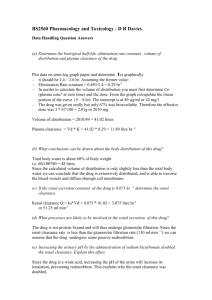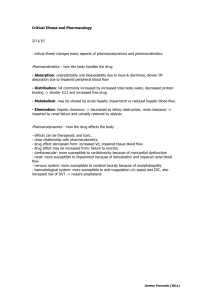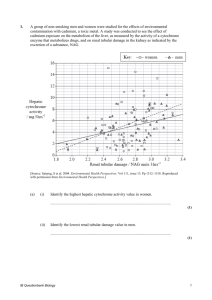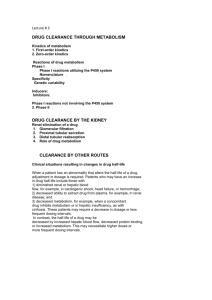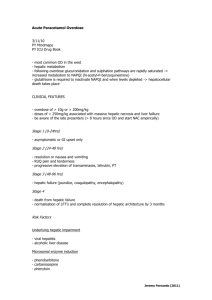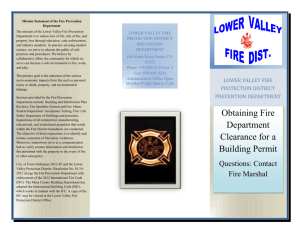Dev. Date
advertisement
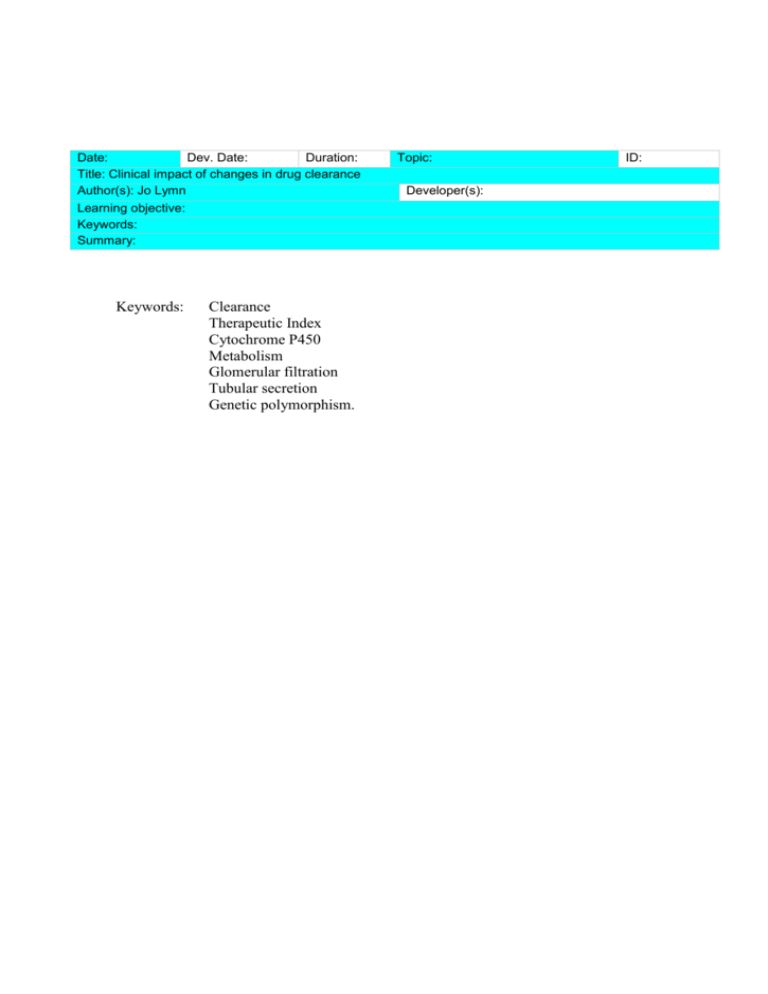
Date: Dev. Date: Duration: Title: Clinical impact of changes in drug clearance Author(s): Jo Lymn Learning objective: Keywords: Summary: Keywords: Clearance Therapeutic Index Cytochrome P450 Metabolism Glomerular filtration Tubular secretion Genetic polymorphism. Topic: Developer(s): ID: Presentation Images Clinical impact of changes in drug clearance Picture 1 (attached, but based on one in half-life RLO) with 3 regions shaded different colours. Add in separate lines as they are verbalised (A decrease in drug clearance will mean that more active drug is present in the body for longer which could lead to the patient developing side effects) and (an increase in drug clearance results in the active drug being present in the patients system for a shorter period of time and might result in a decrease in therapeutic effect.). Words appear on screen as they are spoken ‘Age’ ‘Disease’ etc. The clinical impact of a drug is influenced by the total body clearance of the drug which is itself affected by several factors which will be discussed here. The rate at which a drug is cleared from the body is important clinically as it impacts on how long the active drug is present in the patient’s system. A decrease in drug clearance will mean that more active drug is present in the body for longer which could lead to the patient developing side effects, this is particularly true for drugs which have a narrow therapeutic index such as theophylline. On the other hand an increase in drug clearance results in the active drug being present in the patients system for a shorter period of time and might result in a decrease in therapeutic effect. The rate of total body drug clearance is influenced by a number of factors including age, disease, genetic influences, environmental influences and drug-drug interactions, some of which will be discussed here. Age - neonates Total body clearance is reduced in neonates as a result of the immaturity of physiological processes in both the liver and the kidney. In the liver the activity of both the cytochrome P450 enzyme system required for phase I metabolism and the conjugating enzyme systems required for phase II metabolism are reduced and take several months to reach maturity. Drugs which rely on hepatic clearance can therefore accumulate in the body leading to unwanted side effects and even toxicity. An example of this is ‘Gray Baby Syndrome’ which results from the build-up of the antibiotic chloramphenicol. Chloramphenical is no longer used in neonates for this reason. In terms of renal clearance the rate of glomerular filtration is less than half that of adult values and tubular function is poorly developed in neonates. This means that drugs which rely heavily on renal clearance such as the antibiotic Gentamicin can also build-up in the system and serum concentrations should be determined to ensure appropriate dosing and avoid problems of toxicity. Picture of a newborn baby on screen. Words ‘Total body clearance reduced’ on screen aswell. When verbalise ‘in terms of the liver ….’ Then zoom in to a picture of a liver. Words ‘↓ enzyme activity’ on screen. ‘Grey Baby Syndrome’ and ‘Chloramphenicol’ appear on screen as verbalised. When verbalise ‘In terms of renal clearance….’ Then liver image becomes small but remains on screen, (bottom left corner) and zoom in to picture of kidney. Words ‘↓ glomerular filtration’ and ‘↓ tubular secretion’ on screen as verbalised. ‘Gentamicin’ and ‘toxicity’ appear on screen as verbalised. Age – the elderly Total body clearance in elderly patients is reduced through a reduction in the efficiency of both hepatic and renal mechanisms. Both the liver volume and its blood flow decrease with increasing age being around 35% lower in elderly compared to young adults. Similarly there is a decrease Picture of young adult and elderly person next to each other on screen. in the activity of the metabolising enzyme systems in the liver. This results in a decrease in hepatic drug clearance which may be important when determining appropriate dosages for drugs which rely on hepatic clearance to remove them from the body. For example tricyclic antidepressants should be used at a lower dose in the elderly. In terms of renal clearance there is a reduction in both renal mass and renal perfusion with increasing age. Moreover the rate of glomerular filtration and tubular secretion also reduce with increasing age such that at age 75 the glomerular filtration rate is only 50% of that of a young adult. Indeed the British National Formulary recommends assuming at least mild impairment of renal function when prescribing for the elderly. Zoom in to livers from both – elderly persons liver should be noticeably smaller. ‘↓enzyme activity’ appearing underneath elderly liver. Flash up ‘tricyclic antidepressants’ underneath elderly liver. Livers fade out. Zoom in on perfused kidneys from both adult and elderly. Elderly kidneys should be noticeably smaller and less well perfused (less red) . Flash up ‘Assume mild renal impairment in elderly’ Disease Hepatic and renal function can be affected by a number of disease states which then impacts on drug clearance. Liver disease, including cirrhosis and alcoholic liver disease, will reduce the ability of the liver to effectively metabolise drugs thereby reducing hepatic clearance. Similarly hypothermia affects the rate of hepatic microsomal enzyme activity reducing the clearance of drugs such as propanolol which are predominantly cleared by hepatic mechanisms. Renal disease on the other hand reduces the ability of the kidneys to clear active drug from the body. Shock results in reduced blood flow to body organs including both the liver and the kidneys and will therefore act to reduce both hepatic and renal drug clearance Liver and kidney shown on screen. Series of tabs on bottom of screen labelled ‘chronic renal failure’ ‘cirrhosis’ ‘shock’ and ‘hypothermia’ Click on each of the tabs to discover its effect on drug clearance. Chronic renal disease – zoom in to kidney ‘↓ glomerular filtration’ Cirrhosis – zoom in to liver ‘↓ cytochrome P450 activity’ Hypothermia – zoom in to liver ‘↓ cytochrome P450 activity’ Shock – Zoom in to liver ‘↓blood flow’ followed by zoom in to kidney ‘↓blood flow’ Genetic factors. Genetic polymorphisms or discrete variations in the sequence of certain genes can occur and this is particularly true of the genes which code for the cytochrome P450 metabolising enzymes in the liver. These enzymes can be either more or less active in some people and this will impact on their ability to clear drugs through hepatic mechanisms. People with less active enzymes are poor metabolisers while people with more active enzymes are rapid metabolisers. In rapid metabolisers hepatic clearance will be increased resulting in a shorter half-life of the drug while in poor metabolisers hepatic clearance will be reduced resulting in a longer halflife. These genetic polymorphisms are often more prevalent in specific ethnic groups. For example polymorphisms of the enzyme CYP2C19 affects up to 20% of the Japanese population and decreases their ability to clear drugs such as lansoprazole a proton pump inhibitor. Picture of 3 livers see red drug molecules entering liver and being turned blue (as image in clearance RLO). Liver on left 2 out of every 10 drug molecules turns blue. Labelled ‘poor metabolizer’ Liver in centre 5 out of every 10 drug molecules turns blue. Labelled ‘normal metabolizer’ Liver on right 8 out of every 10 drug molecules turns blue. Labelled ‘fast metabolizer’ Table on screen (attached) one empty column. Student needs to drag and drop either ‘increased drug activity – possible side effects’ or ‘reduced drug activity – possible loss of therapeutic effect’ into column. If right then sticks and they get a ‘Well Done’ if incorrect then doesn’t stick and get the following responses. If answer to A and C wrong then get ‘Sorry this is incorrect – a reduction in the rate of hepatic clearance will prolong the half-life of the drug and may result in side effects’ If answer to B is wrong then get ‘Sorry this is incorrect – an increase in the rate of hepatic clearance will speed up metabolism of the drug, reducing its half-life and possibly leading to loss of therapeutic effect’ Assessment Crossword (See attached word document). Links http://www.blackwellsynergy.com/links/doi/10.1046/j.14401754.1998.00306.x/abs/ Journal of Paediatrics and Child Health (1998) Gentamicin dosage intervals in neonates: Longer dosage interval—less toxicity http://www.merck.com/mmpe/sec20/ch306/ch306b.html# CHDCDDJB ‘Pharmacokinetics in the elderly’ The Merck Manual – online medical library. http://content.nejm.org/cgi/content/full/348/6/529#F4 New England Journal of Medicine (2003) Inheritance and drug response. Vd RLO Half-life RLO Clearance RLO www.icp.org.nz Interactive Clinical Pharmacology site developed in the Department of Clinical Pharmacology, Christchurch Hospital / School of Medicine, New Zealand, Glossary See attached table Clinical Impact of Clearance Across 3. Process that is reduced by up to 50% in elderly people (10,10) 4. Drug which is primarily cleared by renal mechanisms (10) 7. Clearance which is concerned with drug metabolism (7) 8. Specific population who demonstrate reduced hepatic and renal clearance due to organ immaturity (8) 9. Build-up of this drug in neonates is responsible for 'Grey baby syndrome' (15) 10. Organ associated with renal clearance (6) Down 1. Enzyme system found in the liver which is important in hepatic clearance / metabolism. (14) 2. Discrete changes to the genetic sequence encoding cytochrome P450 enzymes, often related to ethnicity. (13) 5. Disease state which acts to reduce the activity of liver enzymes and therefore hepatic clearance (11). 6. Liver disease related to alcohol consumption and reduces hepatic clearance (9) Answers Across 3 4 7 8 9 10 Glomerular Filtration Gentamicin Hepatic Neonates Chloramphenical Kidney Down 1 2 5 6 Cytochrome P450 Polymorphisms Hypothermia Cirrhosis Population prevalence A Cytochrome P450 enzyme CYP2D6 Hepatic clearance B CYP2D6 20% Ethiopians Increased C CYP2C19 20% Japanese Reduced 6% Reduced Scandanavians Clinical Significance increased drug activity – possible side effects’ reduced drug activity – possible loss of therapeutic effect’ increased drug activity – possible side effects’ Possible answers are; 1. 2. ‘increased drug activity – possible side effects’ ‘reduced drug activity – possible loss of therapeutic effect’ Drugs affected (examples) Metoprolol Nortriptyline Omeprazole Glossary Term Clearance Definition Therapeutic Index A measure of a drug’s value taking into account not only its useful properties but also its toxic effects. A simple measure of benefit versus risk. Drug metabolising enzymes that are embedded in the smooth endoplasmic reticulum of liver cells. Responsible for phase I metabolism Phase I metabolism reactions are catalysed by cytochrome P450 enzymes. These reactions are catabolic and the products can be more chemically reactive. Enzyme systems involved in the attachment of a polar group such as a glucuronyl, a sulphate, a methyl, an acetyl or a glutathione to an active drug. Conjugation is a Phase II metabolism reaction. Phase II reactions involve conjugation Resulting conjugate is almost always pharmacologically inactive and less lipid soluble One of three processes which are critical for renal clearance. Involves the filtration of 20% of renal plasma flow through the glomerular capillaries thus allowing drug molecules to diffuse into the glomerular filtrate. One of three processes which are critical for renal clearance. Involves the transfer of drug molecules to the tubular lumen by two independent, non-selective carrier systems. Changes in the genetic code which occur in a population and result in the production of enzymes, particularly cytochrome P450 enzymes, which as a result may be more or less active than the norm A group of anti-depressant drugs which share similar chemical structure and side effects. Act to prevent the reuptake of both noradrenaline and serotonin in the synapse. Also act as antagonists at Cytochrome P450 Phase I metabolism Conjugating enzyme systems Phase II metabolism Glomerular filtration Tubular secretion Genetic Polymorphism Tricyclic antidepressants The rate of drug elimination divided by the plasma concentration of the drug muscarinic and histamine receptors Proton Pump Inhibitors A group of drugs which act to reduce acid secretion in the stomach be irreversibly inhibiting the H+/K+ ATPase enzyme or proton pump Plasma concentration of drug Reduced hepatic clearance Possible toxicity Therapeutic Range Increased hepatic clearance Loss of therapeutic effect Time For data on graph see attached figure and half-life RLO Three lines showing half-lives and reaching steady state. One line in therapeutic range, one in ‘loss of therapeutic activity’ range and one in ‘possible toxicity’ range.
